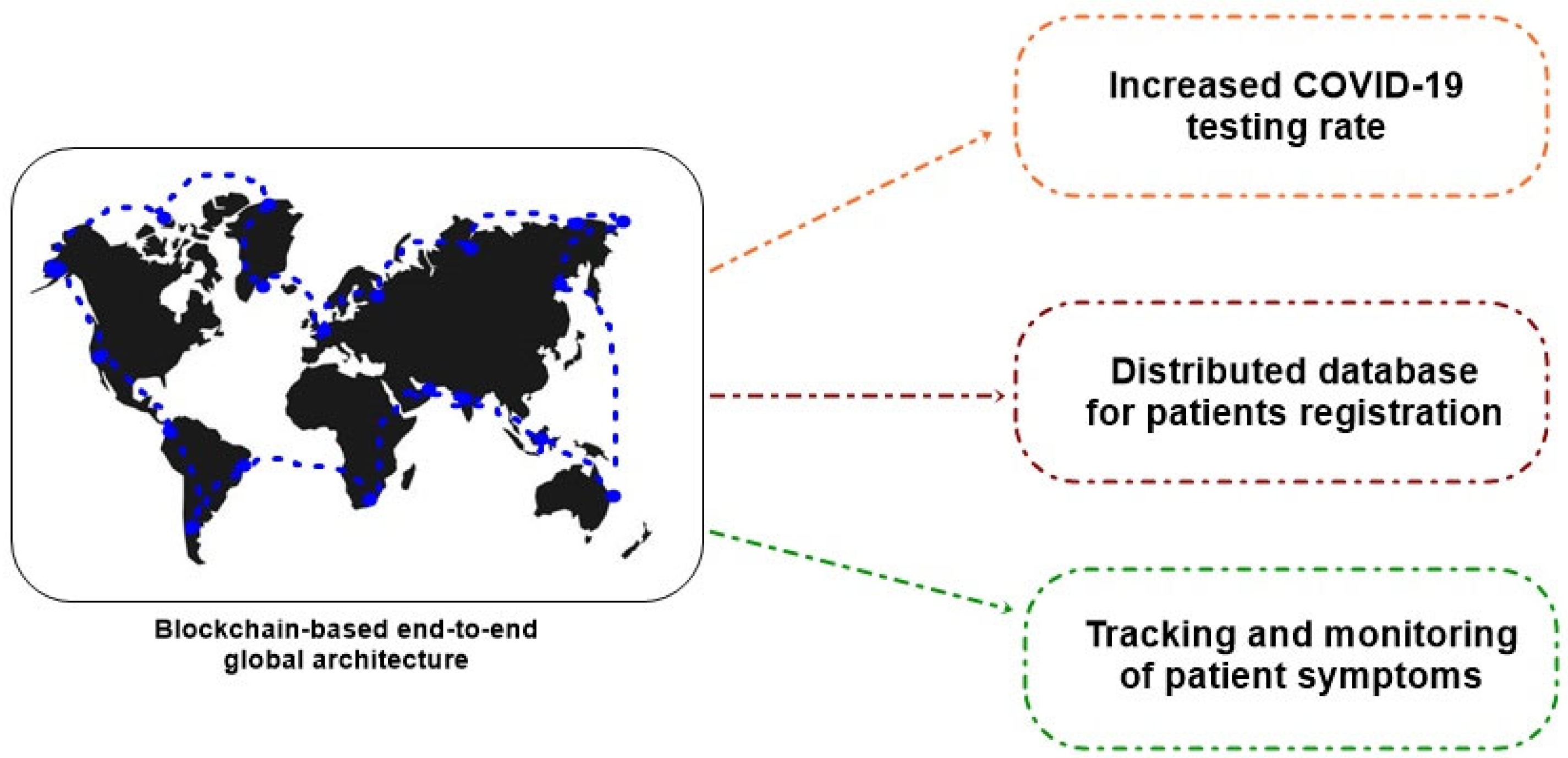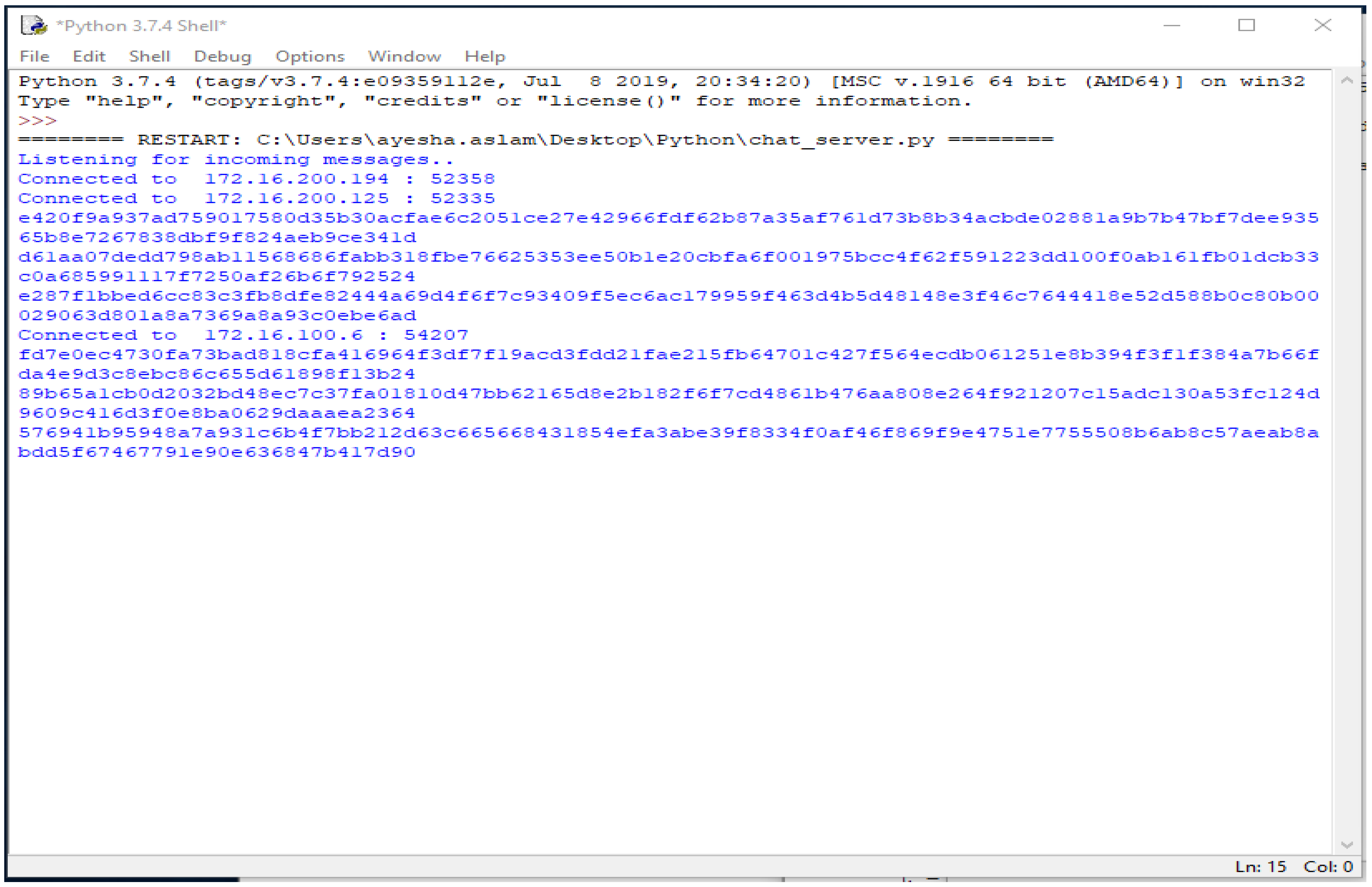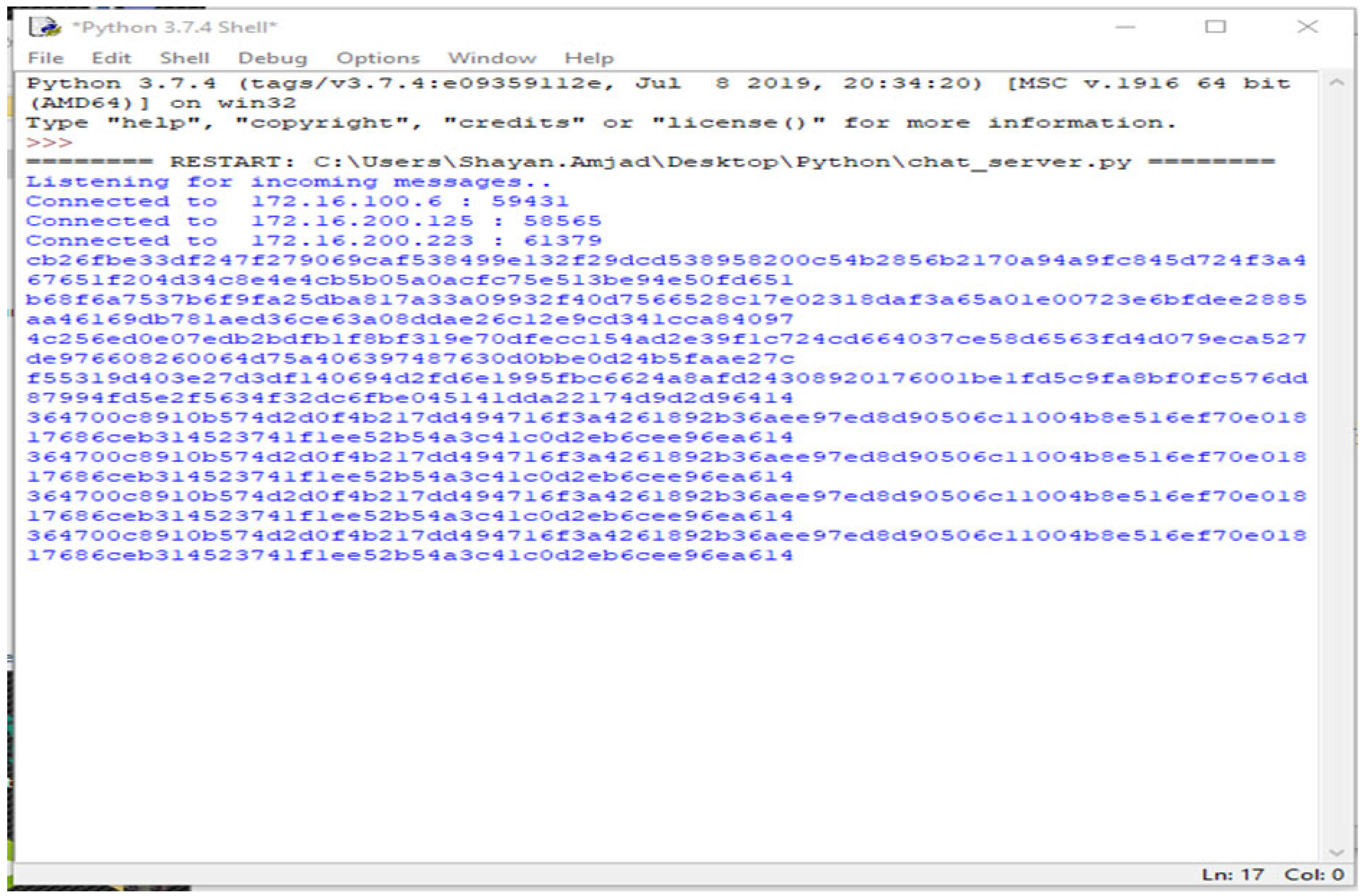Resolving Security Issues in the IoT Using Blockchain
Abstract
1. Introduction
2. Literature Review
3. Materials and Methods
4. Implementation
4.1. Client-Side Implementation Code
4.2. Server-Side Implementation Code
4.3. GUI Implementation Code
| Algorithm 1: Entry of the data |
| Server While(1) i = 0, data = null createsocket() communicateSocketAddress() listeningIncommingConnection() ConnectClient() while(i < no. of client) { Data = listen (client [i]) If data ≠ Ø Generate hash() J = 0 While(i < no. of clients) If(i ≠ j) Share(data, client[i]) Exit() } Client While(1) { createClientSocket() ConnectServer(IP, port) Save(data) Share(data) } closeConnection() |
- Server
- Create a socket
- Share the socket address and continue to watch for incoming connection requests
- Link to client
- Data received
- Create a hash for each received string
- Share the received data with every other connected node
- Repeat steps 5 and 6 as desired by the user.
- Exit.
- Client/Nodes
- Make a distinct client socket for each node.
- Using the provided socket address, connect to the server (IP and port)
- Data sent and received.
- Repeat step 3 as configured.
- Close connection.
5. Analysis and Discussion
6. Conclusions
Author Contributions
Funding
Data Availability Statement
Conflicts of Interest
References
- Lucero, S. IoT Platforms: Enabling the Internet of Things; White Paper; IHS TECHNOLOGY: Landisville, PA, USA, 2016; pp. 1–21. Available online: https://cdn.ihs.com/www/pdf/enabling-IOT.pdf (accessed on 10 October 2022).
- Singh, V.; Dahiya, N. Blockchain-Based Federated Machine Learning for Solving IoT Security Problems. In Applications of Blockchain and Big IoT Systems, 1st ed.; Apple Academic Press: Primary, FL, USA, 2022; pp. 27–56. [Google Scholar]
- Ning, H.; Liu, H.; Yang, L.T. Cyberentity Security in the Internet of Things. Computer 2013, 46, 46–53. [Google Scholar] [CrossRef]
- Heer, T.; Garcia-Morchon, O.; Hummen, R.; Keoh, S.L.; Kumar, S.S.; Wehrle, K. Security Challenges in the IP-based Internet of Things. Wirel. Pers. Commun. 2011, 61, 527–542. [Google Scholar] [CrossRef]
- Pettey, C.; Goasduff, L. Gartner Reveals Top Predictions for IT Organizations and Users for 2011 and Beyond; Gartner: Stamford, CT, USA, 2010; pp. 1–2. Available online: http://www.gartner.com/newsroom/id/1480514 (accessed on 10 October 2022).
- State of the Connected World. 2020 Edition. Available online: https://www.weforum.org/reports/state-of-the-connected-world-2020-edition (accessed on 10 October 2022).
- Abd-Alrazaq, A.A.; Alajlani, M.; Alhuwail, D.; Erbad, A.; Giannicchi, A.; Shah, Z.; Hamdi, M.; Househ, M. Blockchain technologies to mitigate COVID-19 challenges: A scoping review. Comput. Methods Programs Biomed. Update 2020, 1, 100001. [Google Scholar] [CrossRef] [PubMed]
- Chamola, V.; Hassija, V.; Gupta, V.; Guizani, M. A Comprehensive Review of the COVID-19 Pandemic and the Role of IoT, Drones, AI, Blockchain, and 5G in Managing its Impact. IEEE Access 2020, 8, 90225–90265. [Google Scholar] [CrossRef]
- The Economist. The World’s Most Valuable Resource Is No Longer Oil, but Data. 11 May 2017. Available online: https://www.economist.com/leaders/2017/05/06/the-worlds-most-valuable-resource-is-no-longer-oil-but-data (accessed on 10 October 2022).
- Pureswaran, V.; Brody, P. Device Democracy Saving the Future of the Internet of Things IBM Institute for Business Value. 2015, p. 26. Available online: https://www-935.ibm.com/services/multimedia/GBE03620USEN.pdf (accessed on 10 October 2022).
- Ericsson Mobility Report November 2021. Available online: https://www.ericsson.com/en/reports-and-papers/mobility-report/reports/ (accessed on 10 October 2022).
- Christidis, K.; Devetsikiotis, M. Blockchains and Smart Contracts for the Internet of Things. IEEE Access 2016, 4, 2292–2303. [Google Scholar] [CrossRef]
- Abdmeziem, R.; Tandjaoui, D. Internet of Things: Concept, Building blocks, Applications and Challenges. arXiv 2014, arXiv:1401.6877. [Google Scholar]
- Xu, W.; Trappe, W.; Zhang, Y.; Wood, T. The feasibility of launching and detecting jamming attacks in wireless networks. In Proceedings of the International Symposium on Mobile Ad Hoc Networking and Computing (MobiHoc), Urbana-Champaign, IL, USA, 25–28 May 2005; pp. 46–57. [Google Scholar] [CrossRef]
- Xu, W.; Wood, T.; Trappe, W.; Zhang, Y. Channel surfing and spatial retreats: Defenses against wireless denial of service. In Proceedings of the 2004 ACM Workshop on Wireless Security, WiSe, Philadelphia, PA, USA, 1 October 2004; pp. 80–89. [Google Scholar]
- Hong, C.-C.J.K.Y.-W.P.; Lan, P.-C. WLAN Security WP|MY Notes BLOG. Available online: https://glw168.wordpress.com/tag/wlan-security-wp/ (accessed on 25 November 2019).
- Pecorella, T.; Brilli, L.; Mucchi, L. The Role of Physical Layer Security in IoT: A Novel Perspective. Information 2016, 7, 49. [Google Scholar] [CrossRef]
- Xiao, L.; Greenstein, L.J.; Mandayam, N.B.; Trappe, W. Channel-Based Detection of Sybil Attacks in Wireless Networks. IEEE Trans. Inf. Forensics Secur. 2009, 4, 492–503. [Google Scholar] [CrossRef]
- Chen, Y.; Trappe, W.; Martin, R.P. Detecting and Localizing Wireless Spoofing Attacks. In Proceedings of the 2007 4th Annual IEEE Communications Society Conference on Sensor, Mesh and Ad Hoc Communications and Networks, SECON, San Diego, CA, USA, 21 June 2007; pp. 193–202. [Google Scholar] [CrossRef]
- Top IoT Vulnerabilities—OWASP. Available online: https://www.owasp.org/index.php/Top_IoT_Vulnerabilities (accessed on 25 November 2019).
- Bhattasali, T.; Chaki, R. A Survey of Recent Intrusion Detection Systems for Wireless Sensor Network. In Communications in Computer and Information Science, Proceedings of the 4th International Conference, CNSA 2011, Chennai, India, 15–17 July 2011; Springer: Berlin/Heidelberg, Germany, 2011; pp. 268–280. [Google Scholar] [CrossRef]
- Kim, H. Protection against Packet Fragmentation Attacks at 6LoWPAN Adaptation Layer. In Proceedings of the 2008 International Conference on Convergence and Hybrid Information Technology, ICHIT 2008, Daejeon, Korea, 28–29 August 2008; pp. 796–801. [Google Scholar] [CrossRef]
- Hummen, R.; Hiller, J.; Wirtz, H.; Henze, M.; Shafagh, H.; Wehrle, K. 6LoWPAN fragmentation attacks and mitigation mechanisms. In Proceedings of the 6th ACM Conference on Security and Privacy in Wireless and Mobile Networks, Budapest, Hungary, 17–19 April 2013; pp. 55–66. [Google Scholar] [CrossRef]
- Riaz, R.; Kim, K.-H.; Ahmed, H.F. Security analysis survey and framework design for IP connected LoWPANs. In Proceedings of the International Symposium on Autonomous Decentralized Systems, ISADS 2009, Athens, Greece, 23–25 March 2009; pp. 1–6. [Google Scholar] [CrossRef]
- Dvir, A.; Holczer, T.; Buttyan, L. VeRA—Version Number and Rank Authentication in RPL. In Proceedings of the 2011 IEEE Eighth International Conference on Mobile Ad-Hoc and Sensor Systems, Valencia, Spain, 17–21 October 2011; IEEE: New York, NY, USA, 2011; pp. 709–714. [Google Scholar] [CrossRef]
- Weekly, K.; Pister, K. Evaluating sinkhole defense techniques in RPL networks. In Proceedings of the International Conference on Network Protocols, ICNP, Austin, TX, USA, 30 October–2 November 2012; pp. 1–6. [Google Scholar] [CrossRef]
- Ahmed, F.; Ko, Y.-B. Mitigation of black hole attacks in Routing Protocol for Low Power and Lossy Networks. Secur. Commun. Netw. 2016, 9, 5143–5154. [Google Scholar] [CrossRef]
- Pirzada, A.; McDonald, C. Circumventing sinkholes and wormholes in wireless sensor networks. In Proceedings of the Conference on Wireless Ad Hoc Networks, Cancun, Mexico, 6–8 October 2005. [Google Scholar]
- Wazid, M.; Das, A.K.; Kumari, S.; Khan, M.K. Design of sinkhole node detection mechanism for hierarchical wireless sensor networks. Secur. Commun. Netw. 2016, 9, 4596–4614. [Google Scholar] [CrossRef]
- Zhang, K.; Liang, X.; Lu, R.; Shen, X. Sybil Attacks and Their Defenses in the Internet of Things. IEEE Internet Things J. 2014, 1, 372–383. [Google Scholar] [CrossRef]
- Wang, G.; Mohanlal, M.; Wilson, C.; Wang, X.; Metzger, M.; Zheng, H.; Zhao, B.Y. Social Turing Tests: Crowdsourcing Sybil Detection. arXiv 2012, arXiv:1205.3856. [Google Scholar]
- Granjal, J.; Monteiro, E.; Silva, J.S. Network-layer security for the Internet of Things using TinyOS and BLIP. Int. J. Commun. Syst. 2012, 27, 1938–1963. [Google Scholar] [CrossRef]
- Raza, S.; Duquennoy, S.; Chung, T.; Yazar, D.; Voigt, T.; Roedig, U. Securing communication in 6LoWPAN with compressed IPsec. In Proceedings of the 2011 International Conference on Distributed Computing in Sensor Systems and Workshops, DCOSS’11, Barcelona, Spain, 27–29 June 2011; pp. 1–8. [Google Scholar] [CrossRef]
- Granjal, J.; Monteiro, E.; Silva, J.S. Enabling Network-Layer Security on IPv6 Wireless Sensor Networks. In Proceedings of the GLOBECOM—IEEE Global Telecommunications Conference, Miami, FL, USA, 6–10 December 2010; pp. 1–6. [Google Scholar] [CrossRef]
- Brachmann, M.; Garcia-Morchon, O.; Kirsche, M. Security for Practical CoAP Applications: Issues and Solution Approaches. In Proceedings of the 10th GI/ITG KuVS Fachgespraech Sensornetze (FGSN11), Paderborn, Germany, 2011; pp. 69–72. [Google Scholar]
- Granjal, J.; Monteiro, E.; Silva, J.S. End-to-end transport-layer security for Internet-integrated sensing applications with mutual and delegated ECC public-key authentication. In Proceedings of the IFIP Networking Conference, IFIP Networking 2013, Brooklyn, NY, USA, 22–24 May 2013. [Google Scholar]
- Raza, S.; Voigt, T.; Jutvik, V. Lightweight IKEv2: A Key Management Solution for both the Compressed IPsec and the IEEE 802.15.4 Security SPI NH ET ID 1 0 1 1. In Proceedings of the IETF Workshop on Smart Object Security, Citeseer, Paris, France, 23 March 2012. [Google Scholar]
- Peretti, G.; Lakkundi, V.; Zorzi, M. BlinkToSCoAP: An end-to-end security framework for the Internet of Things. In Proceedings of the 2015 7th International Conference on Communication Systems and Networks, COMSNETS 2015, Piscataway, NJ, USA, 6–10 January 2015; pp. 1–6. [Google Scholar] [CrossRef]
- Park, N.; Kang, N. Mutual Authentication Scheme in Secure Internet of Things Technology for Comfortable Lifestyle. Sensors 2015, 16, 20. [Google Scholar] [CrossRef]
- Alkhalil, A.; Ramadan, R.A. IoT Data Provenance Implementation Challenges. Procedia Comput. Sci. 2017, 109, 1134–1139. [Google Scholar] [CrossRef]
- Miller, D. INTERNET OF THINGS Blockchain and the Internet of Things in the Industrial Sector. Available online: www.computer.org/itpro (accessed on 10 October 2022).
- Gao, W.; Hatcher, W.G.; Yu, W. A survey of blockchain: Techniques applications and challenges. In Proceedings of the 2018 27th International Conference on Computer Communication and Networks (ICCCN), Hangzhou, China, 30 July–2 August 2018. [Google Scholar]
- Ni, J.; Zhang, K.; Lin, X.; Shen, X.S. Securing Fog Computing for Internet of Things Applications: Challenges and Solutions. IEEE Commun. Surv. Tutor. 2017, 20, 601–628. [Google Scholar] [CrossRef]
- Alrowaily, M.; Lu, Z. Secure Edge Computing in IoT Systems: Review and Case Studies. In Proceedings of the 2018 IEEE/ACM Symposium on Edge Computing (SEC), Seattle, WA, USA, 25–27 October 2018; Institute of Electrical and Electronics Engineers (IEEE): New York, NY, USA, 2018; pp. 440–444. [Google Scholar]
- Hassija, V.; Chamola, V.; Saxena, V.; Jain, D.; Goyal, P.; Sikdar, B. A Survey on IoT Security: Application Areas, Security Threats, and Solution Architectures. IEEE Access 2019, 7, 82721–82743. [Google Scholar] [CrossRef]
- Tas, Y.; Baeth, M.J.; Aktas, M.S. An Approach to Standalone Provenance Systems for Big Social Provenance Data. In Proceedings of the 2016 12th International Conference on Semantics, Knowledge and Grids, SKG 2016, Beijing, China, 15–17 August 2016; pp. 9–16. [Google Scholar] [CrossRef]
- Lin, Z.; Lin, M.; Wang, J.-B.; de Cola, T.; Wang, J. Joint Beamforming and Power Allocation for Satellite-Terrestrial Integrated Networks with Non-Orthogonal Multiple Access. IEEE J. Sel. Top. Signal Process. 2019, 13, 657–670. [Google Scholar] [CrossRef]
- Lin, Z.; Niu, H.; An, K.; Wang, Y.; Zheng, G.; Chatzinotas, S.; Hu, Y. Refracting RIS-Aided Hybrid Satellite-Terrestrial Relay Networks: Joint Beamforming Design and Optimization. IEEE Trans. Aerosp. Electron. Syst. 2022, 58, 3717–3724. [Google Scholar] [CrossRef]
- Lin, Z.; An, K.; Niu, H.; Hu, Y.; Chatzinotas, S.; Zheng, G.; Wang, J. SLNR-based secure energy efficient beamforming in Multibeam Satellite Systems. IEEE Trans. Aerosp. Electron. Syst. 2022, 1–4. [Google Scholar] [CrossRef]
- Lin, Z.; Lin, M.; de Cola, T.; Wang, J.-B.; Zhu, W.-P.; Cheng, J. Supporting IoT With Rate-Splitting Multiple Access in Satellite and Aerial-Integrated Networks. IEEE Internet Things J. 2021, 8, 11123–11134. [Google Scholar] [CrossRef]








| IoT | 2018 | 2024 | CAGR |
|---|---|---|---|
| Wide-area IoT | 1.1 | 4.5 | 27% |
| Cellular IoT | 1.0 | 4.1 | 27% |
| Short-range IoT | 7.5 | 17.8 | 15% |
| Total | 8.6 | 22.3 | 17% |
| Sr. No. | Security Problem | Result | Damage Layer | Proposed Solution |
|---|---|---|---|---|
| 1 | Jamming entities | Denial of service | Physical | Determining signal strength, calculating packet delivery ratio [14], encoding packets and change in frequencies [15]. |
| 2 | Insecure initialization | Denial of service and compromised the privacy | Physical | Establishing data transmission rates between nodes [16] and inserting fake noise [17]. |
| 3 | Sybil and spoofing attacks | Denial of service and network disturbance | Physical | Signal strength capacities [18], and channel evaluation [19]. |
| 4 | Insecurity of physical level | Denial of service and privacy compromised | Physical | Preventing software access to USB and preventing testing/debugging devices [20]. |
| 5 | Sleep deprivation | Energy expenditure | Link | Multi-layer interruption detection system [21]. |
| 6 | The duplicate attack caused by fragmentation | Denial of service and disturbance | Network | Insertion of timestamp for protecting against replay attacks [22], and fragment authentication through hash [23]. |
| 7 | Vulnerable neighbor discovery | IP spoofing | Network | Elliptic Curve Cryptography (ECC)-based signatures [24]. |
| 8 | Attack on RPL routing | Man-in-the-middle attack and monitoring | Network | Hashing with signature-built verification and observing node behavior [25]. |
| 9 | Wormhole and sinkhole outbreaks | Denial of service | Network | Rank verification through a hash function, trust level supervision, communication behavior evaluation of nodes, anomaly finding through IDS, and measuring signal strength [26,27,28,29]. |
| 10 | Intermediate layer Sybil attack | Privacy breach, spamming, Byzantine errors, inaccurate broadcast | Network | Random social graphs, keeping lists of trusted/un-trusted users by analyzing user behavior [30,31]. |
| 11 | Authentic and secure communication | Privacy breach | Network | Compressed AH, IACAC using Elliptic Curve Cryptography, symmetric homomorphic mapping and distributed logs [32,33,34]. |
| 12 | Transport layer level security | Privacy compromised | Transport | DTLS-PSK with nonces, AES/SHA algorithm-based DTLS cipher, compressed IPSEC, and AES/CCM-based security [35,36,37,38]. |
| 13 | Session establishing and renewal | Denial of service | Transport | Verification with a prolonged secret key, and encryption-based symmetric key [39]. |
| Techniques | Proposed Solutions | Challenges |
|---|---|---|
| Data Provenance | Provenance is a phenomenon in which the origin of the data along with the subsequent changes is traced in order to ensure the precision of data. Data provenance is about the creation of the propagation of the data process and where that data is serving, so this can be used in IoT to ensure confidentiality and integrity of data [40]. | A major challenge faced when implementing data provenance in IoT is that it is compulsory to also secure provenance data. An insecure data provenance means the exposure of sensitive data to unauthorized third parties [40]. |
| Blockchain | Using a distributed, decentralized, shared ledger that is accessible to all parties, blockchain will make it possible to share important relevant data collected from the IoT [41]. | Scalability and availability of blockchain [42]. |
| Fog Computing | Fog computing’s primary function is to locally manage the data produced by IoT devices for better administration, necessitating an architecture made up of various layers. The fog–device framework and the fog–cloud–device framework are two of their frameworks. The device and fog layer make up the former structure, whereas the device, fog, and cloud layer make up the latter framework. Layers are organized according to their capacity for storing and processing information. Wired or wireless communication is used for layer-to-layer communication [43]. | Fog computing inherits the security and privacy issues of cloud computing. The collection, transmission, processing, and exchange of users’ sensitive data make privacy a crucial concern in fog computing. Owners of data are reluctant to reveal their privacy to outside parties, but privacy leakage is unheeded [43]. |
| Edge Computing | Edge computing, which places a small edge server between the user and the cloud or fog, is utilized as a solution to the issues with cloud computing. Instead of the cloud, some processing is undertaken at the edge server. The components of the edge computing architecture are edge devices, cloud servers, and fog nodes [44]. | Data security and user privacy are the two key issues with edge computing. The private information of a user may be exposed and used inappropriately if a home equipped with IoT devices is the target of cyberattacks [44]. |
| Machine Learning | In order to prevent data loss or other problems, the purpose of machine learning is to apply and train algorithms to detect anomalies in IoT devices or to detect any undesired activity taking place in IoT systems [45]. | Raw data of IoT devices cannot be processed by machine learning algorithms. Machine learning requires data to be classified and clustered. The network of IoT devices produces huge amounts of data and, before it is processed by machine learning algorithms, it needs to be cleaned and preprocessed accurately. Failing to do so will result in producing “garbage” data [45]. |
Publisher’s Note: MDPI stays neutral with regard to jurisdictional claims in published maps and institutional affiliations. |
© 2022 by the authors. Licensee MDPI, Basel, Switzerland. This article is an open access article distributed under the terms and conditions of the Creative Commons Attribution (CC BY) license (https://creativecommons.org/licenses/by/4.0/).
Share and Cite
Malik, H.A.M.; Shah, A.A.; Muhammad, A.; Kananah, A.; Aslam, A. Resolving Security Issues in the IoT Using Blockchain. Electronics 2022, 11, 3950. https://doi.org/10.3390/electronics11233950
Malik HAM, Shah AA, Muhammad A, Kananah A, Aslam A. Resolving Security Issues in the IoT Using Blockchain. Electronics. 2022; 11(23):3950. https://doi.org/10.3390/electronics11233950
Chicago/Turabian StyleMalik, Hafiz Abid Mahmood, Asghar Ali Shah, AbdulHafeez Muhammad, Ahmad Kananah, and Ayesha Aslam. 2022. "Resolving Security Issues in the IoT Using Blockchain" Electronics 11, no. 23: 3950. https://doi.org/10.3390/electronics11233950
APA StyleMalik, H. A. M., Shah, A. A., Muhammad, A., Kananah, A., & Aslam, A. (2022). Resolving Security Issues in the IoT Using Blockchain. Electronics, 11(23), 3950. https://doi.org/10.3390/electronics11233950







